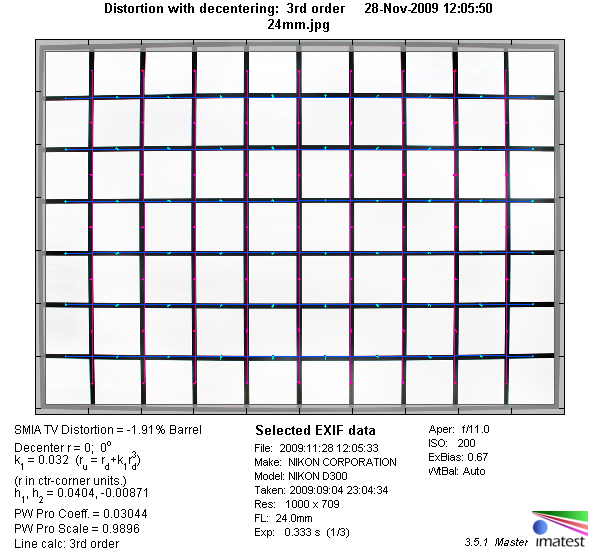|
Page 2 of 3

Distortion
At 24 mm the lens shows pronounced barrel distortion (1.91%), which flips over to the pincushion type at 70 mm, but with around 0.5 % should be field relevant only for critical subjects. At 40 mm the lens is basically distortion-free.
|
Move the mouse cursor over the focal length text marks below to observe the respective distortion
|
| 24mm |
40mm |
70mm |
|

|
The chart above has a real-world size of about 120x80cm.
Vignetting
Typical for most FX lenses used on DX cameras, the amount vignetting is very low and certainly not field relevant.

MTF (resolution)
The lens delivered somewhat disappointing results when we reviewed it on our FX test camera, however on the D200 the lens is able to take advantage of the smaller sensor size which cuts off the critical borders.
The sharpness in the center is generally fine with very good to excellent values at all apertures and focal lengths with only one exception: wide open at 70mm the sharpness drops visibly. The borders also deliver very good to excellent sharpness when the lens is stopped down to f/4 or more. At f/2.8 though the border resolution is only fair. Same applies to the extreme corner performance, stopping down to f/4 delivers very good sharpness at 40 mm, while it takes f/5.6 at 70 mm and even f/8 at 24 mm to reach the same level of sharpness here.
The tested sample suffered from a minor decentering issue. A perfectly centered sample may show slightly higher MTF numbers with large apertures.
Please note that the MTF results are not directly comparable across the different systems!
Below is a simplified summary of the formal findings. The chart shows line widths per picture height (LW/PH) which can be taken as a measure for sharpness.
If you want to know more about the MTF50 figures you may check out the corresponding Imatest Explanations
Chromatic Aberrations (CAs)
Chromatic aberrations (color shadows at harsh contrast transitions) are not really an issue at 40 and 70mm, they might be visible at 24 mm though.
However, CAs can easily be corrected in software or by the camera itself (most modern Nikon DSLRs remove CAs themselves if you shoot JPGs).

Bokeh
A standard zoom is not primarily targeted a portraits, however being a fast lens it allows for good subject separation and thus the quality of out-of-focus blur is certainly of interest. We looked at bokeh with our standard test scene at 70mm focal length, which is closest to classic head to shoulder portrait lenses. Field tests showed that the lens delivers very similar bokeh at all focal lengths, though.
Good news first: the blur in front of the focal plane is very smooth. Unfortunately things look a lot worse behind the focal plane, which is what most photographers a more interested in. As you can see below, the blur is rather nervous and produces ugly outlines and halos.
Thanks to 9 rounded aperture blades, background highlights remain their circular shape throughout the whole aperture range. However, they show significant outlining. This may not seem too critical in the test scene below, however if you take a look at the crops of images from the field below, you get an impression of what to expect using this lens wide open.
The only way to get very smooth bokeh with this lens is to make sure you have a massive distance between your main subject and the background. In summary, this is certainly disappointing.



Bokeh Fringing / Longitudinal Chromatic Aberrations (LoCA)
LoCAs (non-coinciding focal planes of the various colors) are a common issue with relatively fast glass. As you can
notice below the halos have different colors - magenta (red + blue) in front of the focus point
and green beyond. Truly "apochromatic" lenses don't show LoCAs but these lenses are very rare especially
below 100mm. Unlike lateral lateral CAs, LoCAs cannot easily be fixed in post processing.
At it longest focal length of 70 mm (which we used here) the lens shows a rather moderate amount of LoCAs wide open, which is considerably reduced by f/4 already and no longer field relevant at f/5.6 and beyond.
|